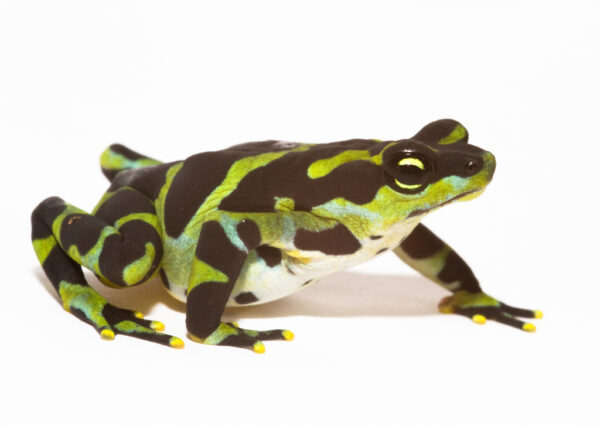Scientific Name: Atelopus limosus
Physical Traits: Bold Colors and Distinctive Markings
- Body Size and Structure: The Limosa Harlequin Frog is a small amphibian, with adult males measuring 3-4 cm (1.2-1.6 inches) in length and females slightly larger at 4-5 cm (1.6-2 inches). Its slender body, long legs, and webbed feet are well-suited for its semi-aquatic lifestyle.
- Coloration: This frog is known for its striking coloration, featuring a base color of black, brown, or green with bright yellow or orange stripes and spots. This bold pattern serves as both a warning to potential predators and as camouflage in its natural habitat.
Life Span: Living on the Edge
- Average Life Expectancy: The Limosa Harlequin Frog typically lives in the wild for 3-5 years, although some individuals may live longer under ideal conditions.
Habitat: Tropical Forests and Mountain Streams
- Geographical Range: This species is endemic to Panama, found primarily in the western and central regions of the country.
- Habitat Preferences: The Limosa Harlequin Frog thrives in humid, tropical montane forests, mainly near fast-flowing mountain streams and rivers.
Diet: A Carnivorous Appetite
- Feeding Habits: As a carnivorous amphibian, the Limosa Harlequin Frog primarily feeds on small invertebrates, such as insects, spiders, and other arthropods.
- Foraging Techniques: This frog is an active hunter, using its long, sticky tongue to snatch up unsuspecting prey.
Reproduction: Aquatic Courtship and Parental Care
- Mating System: Limosa Harlequin Frogs are polygynous, with males competing for access to receptive females during the breeding season.
- Breeding Behavior: Males establish and defend territories near stream banks, engaging in vocalizations and physical displays to attract females.
- Egg Laying and Development: The female lays eggs in shallow water or moist areas near streams, and the male fertilizes them externally. The eggs develop into tadpoles within 2-3 weeks and gradually metamorphose into adult frogs over several months.
Conservation Status: The Struggle for Survival
- Current Status: The Limosa Harlequin Frog is listed as “Critically Endangered” on the IUCN Red List, indicating that it faces an extremely high risk of extinction in the wild.
- Threats: Major threats to this species include habitat loss and degradation due to deforestation, pollution, and climate change, as well as the deadly chytrid fungus, which has decimated amphibian populations worldwide.
- Conservation Efforts: Conservation initiatives for the Limosa Harlequin Frog include habitat protection and restoration, captive breeding programs, and efforts to mitigate the spread of chytrid fungus.
Interesting Facts: Unraveling the Mysteries of the Limosa Harlequin Frog
- The bold coloration of the Limosa Harlequin Frog is an example of “aposematism,” a defense mechanism that warns potential predators of the frog’s toxicity.
- The skin of this frog contains potent toxins known as bufotoxins, which can cause severe reactions or even death in predators that attempt to consume it.
- The Limosa Harlequin Frog is considered an “indicator species,” as its presence or absence can provide valuable information about the overall health of an ecosystem.
- Due to its bright colors and unique markings,
- the Limosa Harlequin Frog has become a popular subject for wildlife photographers and naturalists alike.
- This species is known to exhibit an unusual parental care behavior, with the male frog guarding the eggs and tadpoles until they metamorphose into juveniles.
- The Limosa Harlequin Frog is sensitive to changes in water quality and temperature, making it particularly vulnerable to climate change and pollution impacts.
- In Panama, local conservation organizations and communities have launched awareness campaigns to educate the public about preserving the Limosa Harlequin Frog and its habitat.
- Researchers are studying the toxins present in the skin of the Limosa Harlequin Frog for potential medical applications, including developing new painkillers and antimicrobial agents.
- The distinctive call of the male Limosa Harlequin Frog, which is used to attract females and establish territories, can be heard over the noise of rushing streams.
- Captive breeding programs have been established to help boost the dwindling population of the Limosa Harlequin Frog to reintroduce individuals into protected areas of their natural habitat eventually.
The Limosa Harlequin Frog is a captivating and colorful amphibian that faces significant challenges to its survival. Concerted conservation efforts, including habitat protection, research, and public education, are critical to ensuring the long-term survival of this enigmatic species.


